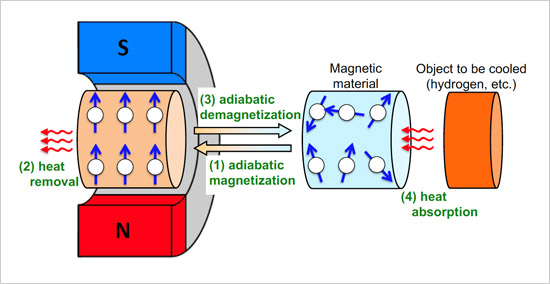World's Best Magnetocaloric Material for H2 Liquefaction discovered via Machine Learning
—A Step Forward for Enabling Efficient Hydrogen Liquefaction, Vital to the Development of a Hydrogen Society—
2020.05.12
National Institute for Materials Science (NIMS)
Japan Science and Technology Agency (JST)
Using machine learning, NIMS has discovered a world-class magnetocaloric material highly suitable for use in hydrogen liquefaction. The use of this material may help to reduce the cost of liquid hydrogen production, which is currently a major intervening factor for the realization of a hydrogen society.
Abstract
- Using machine learning, NIMS has discovered a world-class magnetocaloric material highly suitable for use in hydrogen liquefaction. The use of this material may help to reduce the cost of liquid hydrogen production, which is currently a major intervening factor for the realization of a hydrogen society.
- Hydrogen has the potential to serve as a clean energy source without the emission of CO2—a cause of global warming. As hydrogen gas occupies a lot of space, it has to be liquefied for efficient storage and transportation. However, the hydrogen liquefaction temperature is extremely low (-253°C), and thus cooling hydrogen to this temperature remains costly. Conventional vapor compression refrigeration systems have low liquefaction efficiency (approximately 25%) owing mainly to significant energy loss by the compressor, causing the high cost of hydrogen liquefaction to date. Magnetic refrigeration offers a promising alternative path, as its liquefaction efficiency has been proposed theoretically to be greater than 50%. In magnetic refrigeration, cooling occurs when a magnetic material that is subjected to a magnetic field, has the field removed causing it to exhibit a change in entropy, and to absorb heat corresponding to the amount of the entropy change if the field Is removed adiabatically. To achieve hydrogen liquefaction using magnetic refrigeration, efforts have been made to discover magnetic refrigeration materials capable of exhibiting large entropy changes within hydrogen’s liquefaction temperature range.
- Using machine learning, this research group in NIMS discovered that holmium diboride (HoB2) has a world’s highest volumetric entropy change around the hydrogen liquefaction temperature. The group first searched the literature and collected approximately 1600 data points on magnetic materials whose entropy change values had been reported. Then they used the data to train a machine learning algorithm to correlate the compositions of materials with the associated entropy changes. The group then used the trained algorithm to predict entropy changes in approximately 800 ferromagnetic materials with unknown entropy change values and identified 34 potentially promising materials with relatively high predicted entropy change values. The number of candidate materials was further reduced by selecting materials that were composed of only two chemical elements and then finally narrowed down to one (HoB2) with the highest predicted entropy change value. The group then synthesized and evaluated the magnetocaloric properties of HoB2 and found that it exhibits the world’s largest reported entropy change (ΔS = 0.35 J/cm3K) in the vicinity of the hydrogen liquefaction temperature (~253°C / 20 K).
- Integrating this material into a magnetic refrigeration system would help to achieve a high cooling capability around the hydrogen liquefaction temperature. The research group plans to investigate ways of processing the material into application friendly shapes and performing hydrogen resistant coating, to verify its effectiveness for use in a magnetic refrigeration system. They will also continue searching efficient magnetocaloric materials for use in hydrogen liquefaction systems, to contribute to the realization of a hydrogen society.
- This project was carried out by a research team consisting of Yoshihiko Takano (Group Leader, International Center for Materials Nanoarchitectonics (MANA), NIMS), Kensei Terashima (Senior Researcher, MANA, NIMS) and Pedro Baptista de Castro (Graduate Student Researcher, MANA, NIMS).
This research was conducted in conjunction with another R&D project entitled “Development of advanced hydrogen liquefaction system by using magnetic refrigeration technology” (project leader: Nobuyuki Nishimiya, Invited Researcher, NIMS) supported by the JST-Mirai Program. - This research was published in NPG Asia Materials, an open-access journal, at 1:00 am on May 12, 2020, GMT (9:00 am on May 12, Japan Time).

Figure 1. Magnetic refrigeration working principle
Related files
- MANA
Contacts
(Regarding this research)
-
Yoshihiko Takano
Group Leader,
Nano Frontier Superconducting Materials Group,
Nano-System Field,
International Center for Materials Nanoarchitectonics (MANA),
National Institute for Materials Science (NIMS)
Tel: +81-29-859-2842
E-Mail: takano.yoshihiko=nims.go.jp
(Please change "=" to "@")
(General information)
-
Public Relations Office
National Institute for Materials Science
Tel: +81-29-859-2026
Fax: +81-29-859-2017
E-Mail: pressrelease=ml.nims.go.jp
(Please change "=" to "@") -
Public Relations Division
Japan Science and Technology Agency
Tel: +81-3-5214-8404
Fax: +81-3-5214-8432
E-Mail: jstkoho=jst.go.jp
(Please change "=" to "@")
(Regarding JST projects)
-
Masaru Oya
Department of R&D for Future Creation
Japan Science and Technology Agency
TEL : +81-3-3512-3543
FAX : +81-3-3512-3533
E-Mail: alca=jst.go.jp
(Please change "=" to "@")
Same Keywords
-
Evolving Hydrogen-storage Technology: Guidelines Developed for the Design of Anti-evaporation Catalysts
(JST,hydrogen)
2023.12.15
-
Achieving Cost-Efficient Superalloy Powder Manufacturing Using Machine Learning
(JST,machine learning)
2020.11.30
-
XenonPy.MDL—Comprehensive Library of Pre-trained Models for Predicting Materials Properties
(JST,machine learning)
2019.10.01
Recent Press Release
-
Simultaneous Imaging of Intracellular DNA and RNA Using Harmless Light
2025.10.27
-
Development of an AI Device Using Ion Gel and Graphene That Dramatically Streamlines Machine Learning Computations
2025.10.14
-
Demonstrating a Novel Method to Modulate Heat Flow Through the Collective Motion of Spins
2025.10.06
